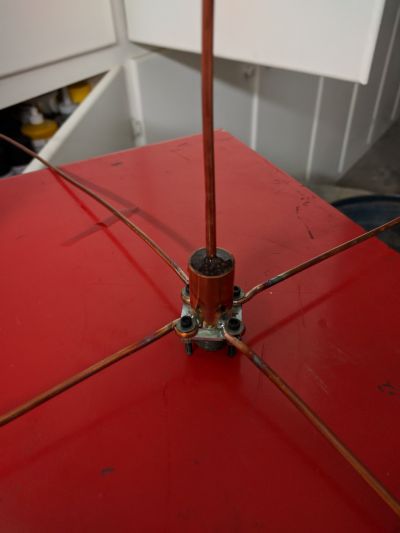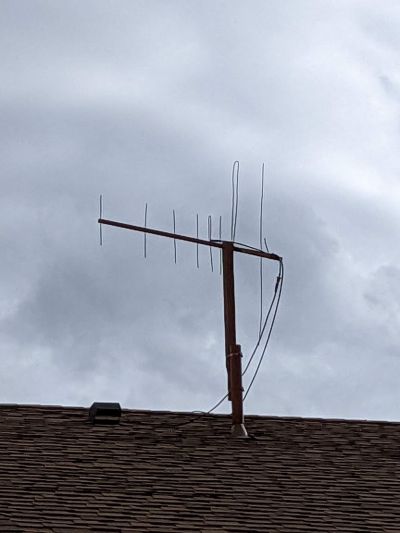Difference between revisions of "VHF and UHF antennas"
(Created page with "Category: Ham Radio ==DIY Vertical antennas== If you want a simple omni-directional antenna, it's hard to beat a vertical. Advantageous over a dipole for focusing the sign...") |
|||
| Line 6: | Line 6: | ||
Here's a design I came up with recently. It uses a chassis mount SO-239 connector with the elements soldered directly on. First I solder on the vertical element, then I solder on a piece of 1/2 copper pipe to go around it as a strain relief. Then solder/bolt on the radials. At the end, I fill the copper pipe up with epoxy. This gives a nice strain relief and has proven quite robust out in the elements. BTW it is important to at least paint the epoxy to protect it from UV. | Here's a design I came up with recently. It uses a chassis mount SO-239 connector with the elements soldered directly on. First I solder on the vertical element, then I solder on a piece of 1/2 copper pipe to go around it as a strain relief. Then solder/bolt on the radials. At the end, I fill the copper pipe up with epoxy. This gives a nice strain relief and has proven quite robust out in the elements. BTW it is important to at least paint the epoxy to protect it from UV. | ||
| + | |||
| + | ==DIY Yagi antennas== | ||
| + | I ran across this design and I think it's really clever - a yagi with no gamma/hairpin match needed. It's designed for simple and quick construction. I've had it up for a couple years and it's worked really well. He has a couple excellent articles on this, search the following link for "Cheap yagi" | ||
| + | |||
| + | https://www.wa5vjb.com/references.html | ||
| + | |||
| + | [[File:PXL_20221207_202053670.jpg|400px|CheapYagi on my roof]] | ||
Revision as of 23:25, 5 December 2023
DIY Vertical antennas
If you want a simple omni-directional antenna, it's hard to beat a vertical. Advantageous over a dipole for focusing the signal more toward the horizon, they are simple to build and are usually sufficient for most vhf/uhf needs. There are lots of sites on the internet telling you how to calculate the length of the elements so I won't duplicate that here. My technique is to start with a quarter wavelength for the frequency you want, then connect an antenna analyzer (or in recent years, a nano-VNA) and trim until it resonates where you like.
Here's a design I came up with recently. It uses a chassis mount SO-239 connector with the elements soldered directly on. First I solder on the vertical element, then I solder on a piece of 1/2 copper pipe to go around it as a strain relief. Then solder/bolt on the radials. At the end, I fill the copper pipe up with epoxy. This gives a nice strain relief and has proven quite robust out in the elements. BTW it is important to at least paint the epoxy to protect it from UV.
DIY Yagi antennas
I ran across this design and I think it's really clever - a yagi with no gamma/hairpin match needed. It's designed for simple and quick construction. I've had it up for a couple years and it's worked really well. He has a couple excellent articles on this, search the following link for "Cheap yagi"

